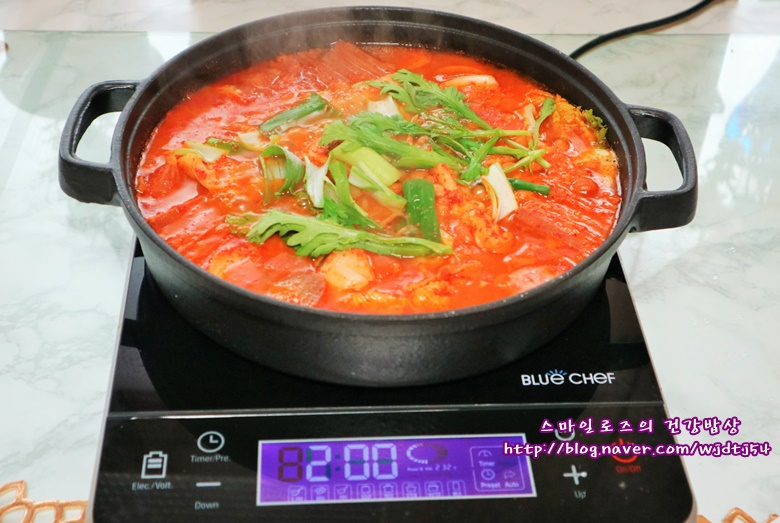Spicy and Hearty Budae-jjigae (Army Stew), Kept Warm to the Last Bite with a Cast Iron Pot
Boiling Hot on Your Dining Table This Winter! Budae-jjigae Recipe Enhanced with a Cast Iron Pot for Lasting Warmth

As the weather turns cold, nothing beats a steaming hot stew at the dinner table! Budae-jjigae, or ‘Army Stew’, is perfect for such occasions, and using a cast iron pot ensures it stays wonderfully warm from the first spoonful to the last. Instead of rich bone broth, we’ll use a clean and refreshing rice water base for a lighter yet deeply flavorful soup. For a satisfying meal, consider adding dumplings and rice cake slices instead of ramen noodles. Fresh perilla leaves and green onions add a final flourish of aroma and taste.
Main Ingredients- 1 can Baked Beans
- 250g Ham (Spam or canned ham)
- 3 Sausages
- 150g Bacon
- 150g Ground Pork
- 100g Napa Cabbage
- 100g Kimchi (fermented)
- 1/2 Green Onion
- A handful of Perilla Leaves
Seasoning and Broth- 3 Tbsp Gochugaru (Korean chili flakes)
- 1 Tbsp Gochugaru Oil
- 2 Tbsp Guk-ganjang (Korean soup soy sauce) or Fish Sauce
- 800ml Rice Water (approx. 4 cups)
- 3 Tbsp Gochugaru (Korean chili flakes)
- 1 Tbsp Gochugaru Oil
- 2 Tbsp Guk-ganjang (Korean soup soy sauce) or Fish Sauce
- 800ml Rice Water (approx. 4 cups)
Cooking Instructions
Step 1
First, prepare the rice water, which will add a depth of flavor to your Budae-jjigae. This is made by collecting the cloudy water after rinsing rice. It creates a clean yet satisfying broth base, a secret to its delicious taste. Adding a bit of napa cabbage will also enhance the soup’s refreshing quality, so be sure to include it.

Step 2
Chop all the ingredients into bite-sized pieces. Slice the ham and sausages diagonally, and cut the bacon into 3-4 cm lengths. Chop the kimchi into suitable pieces and slice the green onion diagonally. Arrange these prepared ingredients attractively around the edge of your cast iron pot.

Step 3
In a bowl, combine the gochugaru, gochugaru oil, and guk-ganjang (or fish sauce) to create a flavorful seasoning paste. Place the baked beans in the center of the pot and generously spoon the prepared seasoning paste over them.

Step 4
Carefully pour the prepared rice water around the edges of the pot. Bring to a boil over high heat. Once it starts bubbling vigorously, consider adding chewy dumplings and rice cake slices instead of ramen noodles for a filling meal that can substitute rice. It’s also a good idea to let it simmer once in the kitchen beforehand to allow the flavors to meld.

Step 5
Transfer the pot to your dining table and continue to simmer it on an induction cooker or portable burner. This way, you can enjoy the Budae-jjigae piping hot until the very last bite. Adding fresh perilla leaves and green onions, perhaps from your own garden, right before serving will enhance the aroma and freshness, creating the ultimate taste experience.




